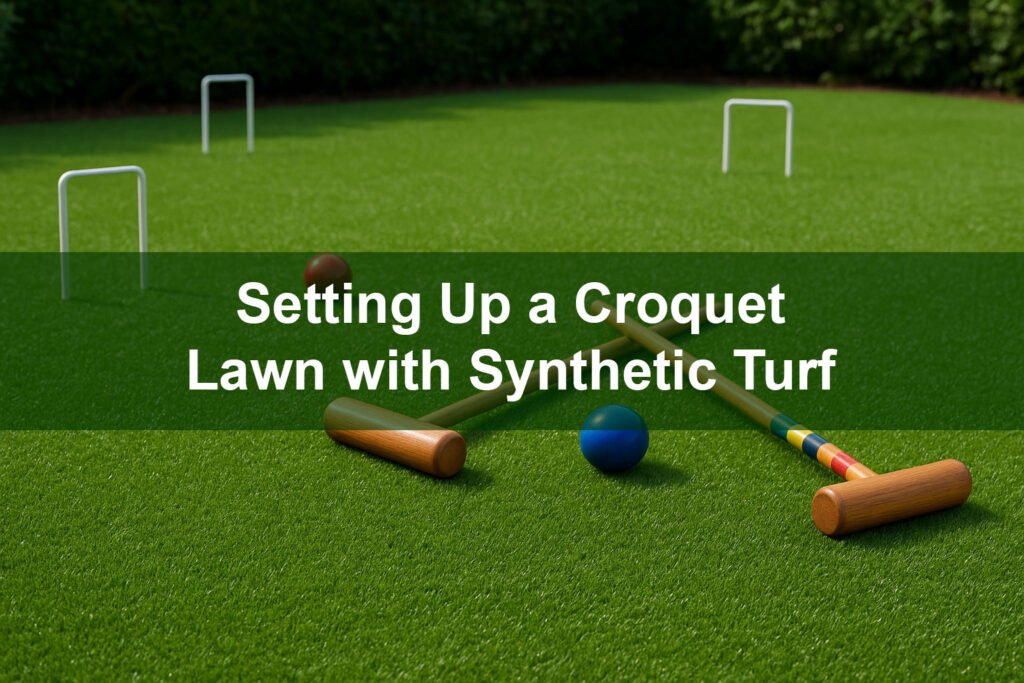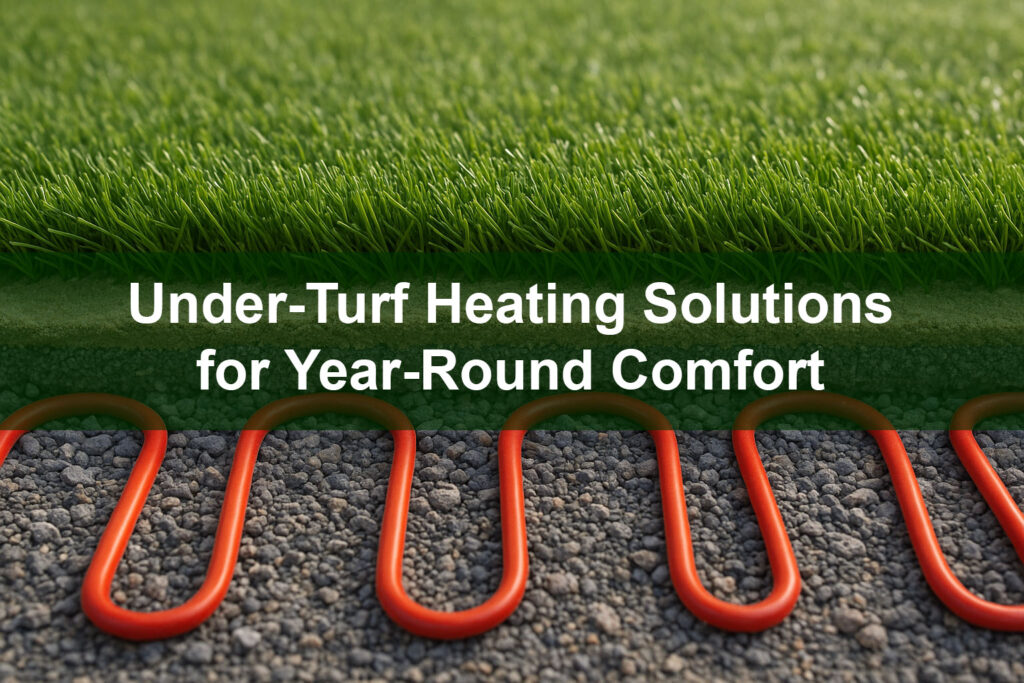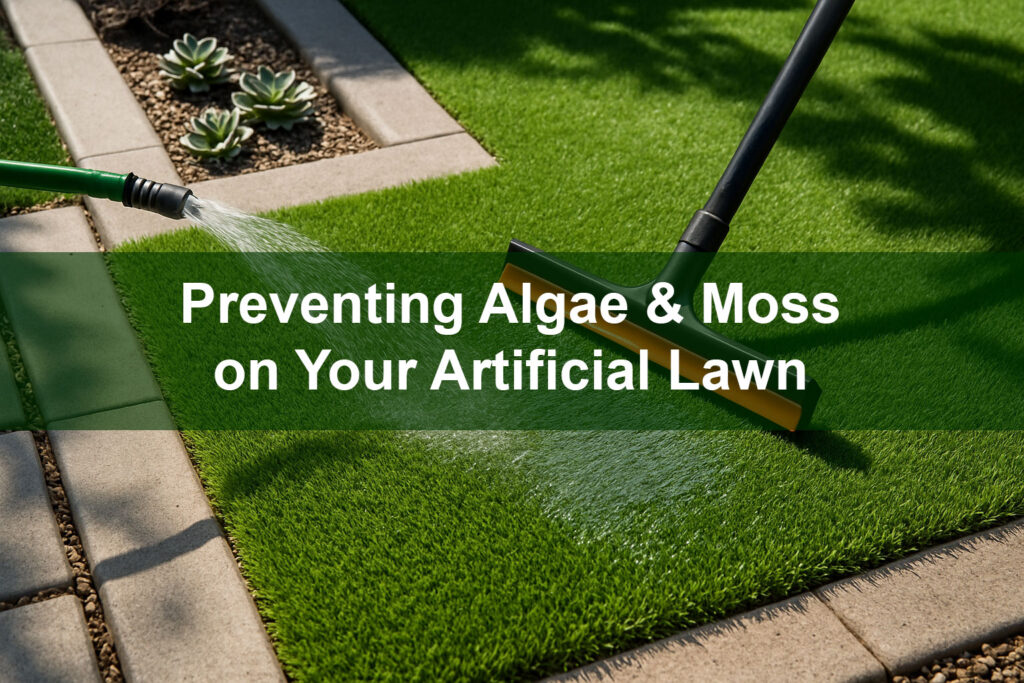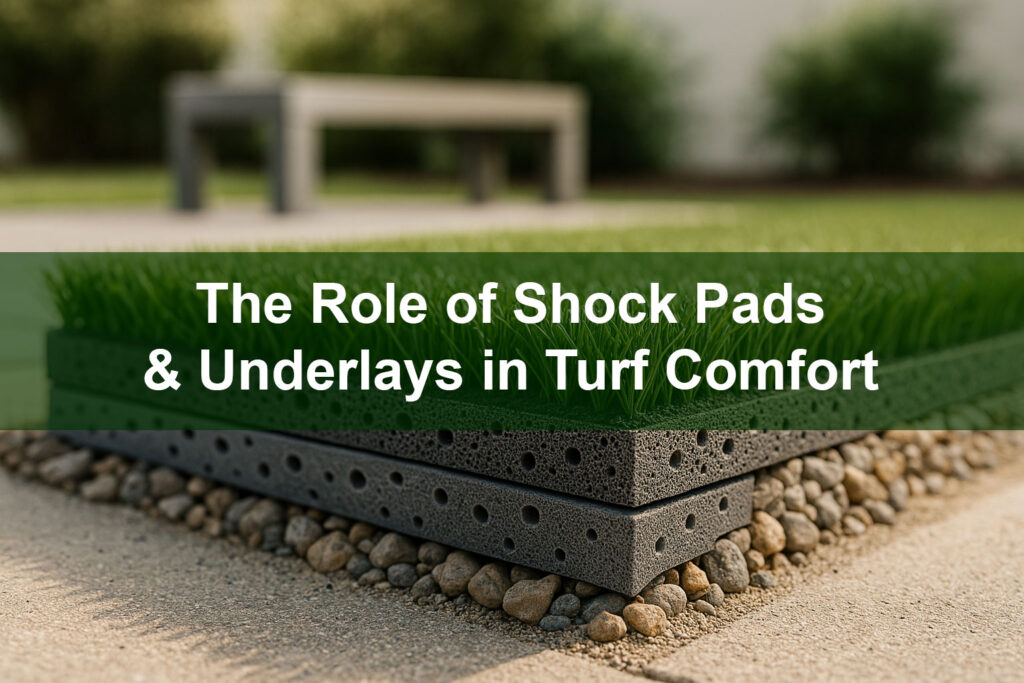When planning your dream lawn, you’ll likely face a crucial decision: artificial grass vs sod?
Both options have their advantages and drawbacks, and the right choice will depend on your needs, budget, and maintenance preferences.
In this guide, we’ll compare artificial grass and sod, helping you determine which is the best fit for your lawn.
Article Preview:
- Quick Comparison Table: Artificial Grass vs. Sod
- Benefits of Artificial Grass: Low-Maintenance and Durable
- Benefits of Sod: Natural Beauty and Cooling Effects
- Cost Comparison: Short-Term vs. Long-Term Expenses
- Environmental Considerations: Sustainability and Impact
- Maintenance Comparison: What Each Option Requires
- Aesthetic Comparison: Realism, Texture, and Visual Appeal
- FAQs About Artificial Grass and Sod
Quick Comparison Table: Artificial Grass vs. Sod


Benefits of Artificial Grass: Low-Maintenance and Durable
Artificial grass is a popular choice among homeowners who want a beautiful, hassle-free lawn.
Here’s why it stands out:
- Minimal Maintenance: Artificial grass eliminates the need for time-consuming chores like mowing, watering, and fertilizing. For homeowners interested in installing it themselves, our step-by-step guide on DIY artificial grass installation can help you achieve professional results. Explore our DIY services for more details on artificial grass installation. Once installed, you can enjoy a pristine lawn with only occasional light maintenance, such as brushing and cleaning debris. This makes it a fantastic option for busy homeowners who want to spend less time caring for their yard.
- Year-Round Beauty: Unlike natural grass that can turn brown or patchy during droughts, winter, or extreme heat, artificial turf maintains its vibrant, lush appearance throughout all seasons. This consistency ensures your lawn remains aesthetically pleasing year-round, boosting curb appeal.
- Durability: High-quality artificial turf is designed to endure heavy foot traffic, pet activity, and harsh weather conditions without showing significant wear. Its resilience makes it an ideal choice for families with children, pet owners, or homes that frequently host outdoor events.
- Water Savings: Artificial grass requires no irrigation, making it a water-efficient solution in areas with frequent droughts or water restrictions. If you’re looking to install a water-conserving artificial lawn, explore our wide range of options on our lawn services page. By switching to artificial turf, homeowners can drastically reduce their water bills and contribute to conservation efforts.
- Pest and Weed Control: Artificial grass does not attract pests like ants or grubs that are common with natural lawns. Additionally, since weeds struggle to grow through synthetic turf, you won’t have to invest time or money in weed control treatments.
- Versatility: Artificial turf can be used in various applications beyond just lawns—it’s perfect for patios, dog runs, playgrounds, rooftop gardens, and sports fields, adding functionality to many outdoor spaces. Our specialized solutions include pet-friendly lawns and sports-ready turf installations. Learn more about creating a pet-friendly yard with artificial grass for pets and sports turf options tailored to athletic fields.
Pro Tip: Modern artificial turf mimics the look and texture of natural grass, with options that closely resemble real grass blades, offering both beauty and practicality.

Benefits of Sod: Natural Beauty and Cooling Effects
For those who prefer a traditional, living lawn, sod can provide many benefits:
- Instant Green Lawn: Unlike grass seed that requires weeks to grow, sod delivers a ready-to-use, lush green lawn immediately after installation. This instant gratification is perfect for homeowners seeking quick results. If you prefer to leave the installation to professionals, our Do It for Me service ensures a stress-free, expertly installed lawn. Discover more about how we handle the installation process with our Do It for Me service.
- Natural Cooling Effect: Living grass acts as a natural coolant, reducing the surrounding air temperature. Sod-covered areas can be significantly cooler than paved or artificial surfaces, making them ideal for outdoor gatherings during warm weather.
- Soil Stabilization: Sod helps prevent soil erosion by anchoring the topsoil in place with its established root system. Enhance your outdoor space with expertly designed sod solutions and complementary features like outdoor living installations. Learn more about transforming your outdoor environment with our outdoor living services. This makes it a valuable choice for areas prone to runoff or erosion issues.
- Biodiversity: A sod lawn supports a wide variety of beneficial organisms, including earthworms and insects, which can contribute to healthier soil and a balanced ecosystem.
- Improved Air Quality: Natural grass absorbs carbon dioxide and releases oxygen, contributing to cleaner air. It also filters dust and other pollutants, promoting a healthier outdoor environment.
Although sod offers many benefits, it requires consistent care, especially during the initial establishment phase to ensure long-lasting success.
Discover how sod promotes sustainable landscaping by improving air quality, conserving soil, and enhancing biodiversity through the GVT guide on the Environmental Benefits of Sod.

Cost Comparison: Short-Term vs. Long-Term Expenses
Artificial Grass Costs:
Artificial grass involves a significant upfront investment, with prices typically ranging from $5 to $20 per square foot, depending on quality and installation.
However, the ongoing maintenance costs are minimal, as there’s no need for regular mowing, watering, or fertilization.
Over the course of 10 to 20 years, homeowners can save thousands of dollars in maintenance expenses.
Long-Term Benefits:
- Reduced water bills due to no irrigation.
- Savings on landscaping and lawn care services.
- Long lifespan of 10-20 years ensures durable value.
For detailed insights on pricing, factors affecting costs, and budgeting tips for synthetic turf, explore our blog post on How Much Does Artificial Grass Cost.
Sod Costs:
Sod is more affordable initially, costing between $0.30 to $0.85 per square foot. However, the long-term costs can accumulate due to the continuous need for watering, fertilizing, mowing, and pest control. Maintenance costs may range from $1,500 to $2,500 per year, depending on lawn size and location.
Long-Term Benefits:
- Natural, authentic feel with cooling effects.
- Healthier soil due to natural biodiversity.
- Potentially higher property value in regions where natural lawns are highly desirable.
Example: Over a 10-year period, the cumulative cost of maintaining sod, including water, fertilizer, and labor, can easily surpass the initial investment of artificial grass. However, sod provides the benefit of natural beauty and environmental contributions that artificial grass cannot replicate.

Environmental Considerations: Sustainability and Impact
Choosing between artificial grass and sod often comes down to more than just aesthetics or maintenance—environmental impact plays a critical role.
Each option has its advantages and drawbacks when it comes to sustainability and ecological balance.
Artificial Grass:
- Water Conservation: One of the biggest environmental benefits of artificial grass is its ability to conserve water. In areas prone to drought or water restrictions, synthetic turf can significantly reduce water usage compared to natural lawns.
- No Chemical Fertilizers or Pesticides: Artificial grass eliminates the need for chemical inputs, which can leach into the soil and nearby water sources. By reducing the use of fertilizers and pesticides, homeowners contribute to cleaner waterways and healthier ecosystems.
- Durability and Longevity: High-quality synthetic turf can last 10-20 years, minimizing the need for frequent replacements and reducing waste.
- Challenges: Some artificial grass options are made from non-biodegradable materials. Once disposed of, they may contribute to landfill waste if not recycled. However, advancements in eco-friendly manufacturing have led to the development of turf made from recycled materials.
Sod:
- Natural and Eco-Friendly: As a living, breathing system, sod promotes biodiversity by supporting earthworms, insects, and microbes that contribute to soil health.
- Carbon Sequestration: Natural grass absorbs carbon dioxide and releases oxygen, playing a role in reducing atmospheric CO2 levels.
- Water-Intensive: Maintaining a sod lawn requires significant amounts of water, especially in hot and dry climates. This can put stress on local water supplies, making it a less sustainable choice in drought-prone areas.
- Fertilizer and Pesticide Use: Sod lawns often require chemical treatments to thrive, which can pose risks to nearby ecosystems and groundwater.
Tip: Look for eco-friendly artificial turf options made from recycled materials or opt for drought-tolerant sod varieties that require less water and fewer chemicals.
For valuable tips on reducing outdoor water consumption and creating water-efficient landscapes, check out the EPA’s Landscaping Tips , which provide expert guidance on sustainable lawn care and irrigation.

Maintenance Comparison: What Each Option Requires
Proper maintenance plays a crucial role in the long-term performance and appearance of your lawn.
Here’s a detailed comparison of what artificial grass and sod require to stay in top shape.
Artificial Grass Maintenance:
- Minimal Effort: Artificial grass is designed to be low-maintenance. Occasional tasks include clearing debris, such as leaves or dirt, to keep the surface clean.
- Brushing: Periodic brushing helps maintain the upright position of the grass blades, especially in high-traffic areas where the blades may flatten.
- Rinsing: In areas where pets frequently use the lawn, rinsing with water helps eliminate odors and keep the surface hygienic.
- Weed Prevention: Though rare, weeds can grow around the edges or through drainage holes. Applying a weed barrier during installation and periodic inspection can prevent growth.
For more tips on maintaining a pristine artificial lawn, visit our blog post on the Ultimate Guide to Cleaning Artificial Grass, where we cover expert advice on cleaning, debris removal, and keeping your turf fresh year-round.
Sod Maintenance:
- Watering: Sod requires consistent watering, especially during the first few weeks after installation to help establish strong roots. During hot or dry periods, regular irrigation is crucial to prevent brown patches.
- Mowing: Once the sod is established, frequent mowing is needed to maintain an ideal grass height and promote healthy growth.
- Fertilizing: Sod lawns thrive with periodic fertilization to provide essential nutrients for growth and vibrancy.
- Weed and Pest Control: Natural grass is susceptible to weeds, pests, and diseases, making regular monitoring and the application of weed control treatments necessary.
Which Option Wins?
If you prioritize convenience and want a lawn that requires minimal maintenance, artificial grass is the clear winner. However, if you enjoy hands-on lawn care and value the natural appeal of living grass, sod may be more rewarding in the long run.

Aesthetic Comparison: Realism, Texture, and Visual Appeal
When it comes to aesthetics, both artificial grass and sod offer appealing options, but their differences lie in texture, feel, and overall authenticity.
Artificial Grass:
- Realistic Appearance: High-quality artificial grass products today are engineered with advanced technology that mimics the natural variations found in real grass, including color tones, blade shapes, and textures.
- Consistency: One of the standout features of artificial grass is its uniformity. Unlike sod, which can develop uneven patches or discoloration, artificial turf offers a consistently green and lush appearance year-round.
- Durability Over Time: Artificial grass resists fading from sun exposure and doesn’t develop brown spots, making it an ideal option for homeowners who prioritize a flawless, maintained look without the hassle.
- Feel Underfoot: While advancements have made artificial turf softer and more comfortable, it may still lack the natural coolness and softness that real grass provides, especially on hot days.
Sod:
- Authentic Texture: Sod delivers the genuine texture of living grass, providing a soft, springy feel underfoot that many homeowners cherish. The natural coolness of real grass makes it ideal for barefoot walking or playing.
- Natural Scent: Freshly cut grass has an iconic scent that artificial grass cannot replicate. For homeowners who love this sensory aspect, sod offers an unparalleled experience.
- Variation and Growth: Unlike artificial turf, sod is dynamic and ever-changing. As it grows, it can develop unique characteristics, such as subtle color variations, that enhance its natural beauty.
- Potential for Imperfections: Over time, sod can develop brown spots, weeds, or bare patches if not maintained properly, but these are often part of its charm for those who appreciate nature.
Choosing Based on Aesthetics:
If you prioritize a perfectly maintained, consistent look with minimal effort, artificial grass may be the best fit. However, if you value the natural texture, scent, and evolving characteristics of living grass, sod could be the ideal option.

FAQs About Artificial Grass and Sod
How long does artificial grass last?
- High-quality artificial grass can last between 10-20 years with proper care. The longevity depends on factors such as the quality of the materials, the level of foot traffic, and periodic maintenance, like brushing to keep the blades upright and removing debris. Modern synthetic grass is UV-resistant, meaning it won’t fade or degrade quickly under sunlight, making it ideal for long-term use.
Can sod be installed year-round?
- Sod can be installed during most seasons, but spring and early fall are ideal for optimal growth. Installing sod during these periods allows the grass to establish strong roots before extreme weather conditions, such as winter frost or summer heat, set in. However, with proper care and watering, sod can successfully be installed even in less-than-ideal conditions.
Is artificial grass pet-friendly?
- Yes, it is pet-friendly and resistant to digging and pet waste. Unlike natural grass, artificial turf won’t develop muddy patches from pets, and it’s easy to clean by simply rinsing with water. Additionally, many artificial turf products are designed with odor-reducing infill to minimize the smell of pet waste, making them an excellent option for pet owners.
How soon can I use my sod lawn after installation?
- You should wait 3-4 weeks before heavy use to allow the roots to establish. During this period, frequent watering is essential to ensure the sod binds to the soil and grows healthy, deep roots. Walking on it too early can cause uneven patches or damage the delicate root system, so it’s important to follow the recommended waiting period for best results.
Conclusion: The Lawn of Your Dreams Awaits
When considering artificial grass vs. sod, your decision ultimately depends on factors such as lifestyle, budget, and environmental concerns.
Artificial grass offers a low-maintenance, water-saving option that stays green year-round, making it ideal for busy homeowners and regions with water restrictions.
On the other hand, sod provides the natural beauty, cooling benefits, and biodiversity that nature lovers often seek.
To make the most informed decision, evaluate your priorities—whether you prefer the convenience of synthetic turf or the authentic charm of a living lawn.
Ready to take the next step? Explore our lawn services or contact us today for expert advice on choosing the perfect lawn solution that meets your needs.







